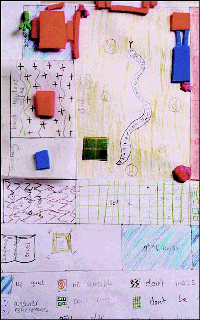Child's Play
 Lottie Child is an artist practising on children. She started in her own building in Fitzrovia, London, exploring it with neighbouring kids in a holiday programme. Together, they developed ways to hide notes from each other and made up their own cryptographic system for sending signals across the light well: whistling, notes hung through windows, and a semaphore embedded in normal household activities.
Lottie Child is an artist practising on children. She started in her own building in Fitzrovia, London, exploring it with neighbouring kids in a holiday programme. Together, they developed ways to hide notes from each other and made up their own cryptographic system for sending signals across the light well: whistling, notes hung through windows, and a semaphore embedded in normal household activities.
Together with pupils at London’s Emmanuel Primary School in West Hampstead, Child recently experimented with flying cameras on helium balloons. She wanted to look at the school’s space, how the kids move around it, what physical restraints they encounter and how they understand these restrictions. Child was placed at the school by Camden Arts’ Art & Technology residency programme (2002).
After some reflection, she took a wireless Xcam10 (a miniature video transmitter), three red helium balloons and a bar of wire for image-stabilisation/anti-spin. She went outside at playtime with a kite reel and a class of 11 year olds and sent the camera up; the kids ran around screaming, then watched the playback on TV. The first footage was jolty and the children weren’t that impressed – they thought it was like television, but crap – so they made her do it again, getting it smoother via a better kite-reeling action. You don’t always find this kind of technical rigour in the art world.
The result is surveillance video reconfigured: momentary, drifty and unsustainable, more like a flying dream on balloon-lifespan. It’s emotionally involving: when the balloon crashlands you’re there, you’re in it – and then it survives. The kids called it action-movieish.
The view is of a small yard in the centre of the school, a flat clump of buildings. The Headmistress’ office is the only thing on the second floor. Simple Foucauldian manoeuvring: she gets to look out on lunchtime. But Child’s balloon cam went just a bit higher...
The class took stills from the video and added keys and subjective information to make maps of the school to give out to new kids, to aid them in getting around, physically and socially. Different colours and patterns indicated different rules. For example:
Playground: BE LOUD BE WILD; Classrooms: BE QUIET BE HELPFUL BE SENSIBLE; Head’s office: BE VERY VERY GOOD.
Putting things in terms of rules was the kids’ idea, Child says. Or things that had happened: JAMES HAD A NOSEBLEED (playground, next to the painted snake); MALAYA BEAT UP RACHAEL (playground).
They were also interested in the staff room, and what could go on in there. It was an unimaginable place. So Child went in with a spycam and chatted for a bit with the caretaker: the class went mad when she showed them the footage.
Child isn’t interested in being a kids spy cam professional, though. Her next commission is for Climbing Club, a project in a girls’ school in Bow, conceived as a way to create an emotional weather map for the pupils. Although she concedes there may be problems with getting the school authorities to allow a climbing tour of the school, Child’s project to subtly introduce kids to the idea that there are only certain prescribed ways for them to move seems one worth pursuing.
Images from the balloon cam will be exhibited in the Swiss Cottage Library, 3 May – 7 June 2003
Lottie Child: [http://twenteenthcentury.com/lottie]
Mute Books Orders
For Mute Books distribution contact Anagram Books
contact@anagrambooks.com
For online purchases visit anagrambooks.com








